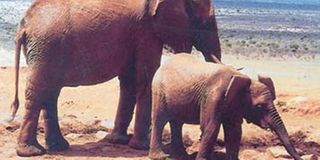Eating our wildlife to extinction?

One of the animals in Kenya most priced for their meat - the elephant. It is estimated that more than a third of the meats sold at the city markets are from such animals.
Quite a large fraction of the meats sold at the Nairobi markets are not beef, mutton or goat meat. In fact, more than a third of those so far analysed are from the bush.
The preliminary analysis only differentiates between bush meat and the three types, but a further study that identifies the game meat up to the species, is under way.
The analysis is supported by Kenya Wildlife Coalition, and its report is likely to send shock waves in Kenya’s conservation circles and the nyama choma (roasted meat) enthusiasts. It also comes at a time when major conservationists are seeking new ideas on wildlife use in Kenya.
At the weekend, for instance, they held a three-day conference in Mombasa. And at a meeting at the African Medical Research Foundation (Amref) headquarters at Langata, Nairobi, shocking figures were given over the extent of bush meat trade in Kenya and other African countries.
Noted the chairman of East African Wildlife Society, Dr Imre Loeffler, who is also a renowned physician: After charcoal burning, the trade is the second most successful jua kali (informal sector) business in Kenya." Last year, 82 people were caught with bush meat, while 22 have been seized this year. It is believed the meat finds its way to city outlets such as Burma market in Eastlands from the game sanctuaries.
Wildlife experts fear that the trade is now being taken over by wealthy people, and it is now recognised as a major direct cause of wildlife declines in eastern and southern Africa.
"A survey shows that 58 per cent of Kenya’s wildlife has been lost in the last 20 years, and most of this is attributed to the bush meat trade," said a participant at the Mombasa meeting.
Apart from the cruelty with which the animals are killed, the trade is characterised by wastefulness and, as Dr Loeffler told the conference, there are better ways to utilise wildlife; this is an abomination.
Defined as "illegal trade in wild animal meat", Dr Loeffler’s statement is an indication of the extent of this business. The chairman of the Youth for Conservation group, Mr Franklin Omondi, said that since 1994, some 48,000 snares had been removed from areas where both protected and non-protected animals are found.
The mostly wire traps are the main tools of the trade, and are especially abundant in poor areas where the residents cannot afford the relatively high cost of beef and other legal protein sources. Makueni, Kitui and Taita Taveta districts are such areas, where the snares represent a mere 10 per cent of the total, according to a participant.
A study conducted in 2000 showed that 80 per cent of the Kitui residents depended on bush meat as a protein source, and that the meat was 129 per cent cheaper than beef or goat meat.
But the issue is not as simple as it might sound. At the core of the debate is whether or not wildlife should be managed and protected for food. As some participants noted, some people do not know that killing animals for food is illegal.
As the conference noted, hunting for meat is a centuries-old tradition in Africa. "However, in the olden days, there was sustainable harvesting that was regulated by a set of rules and traditions, and it was clearly defined what animals could be killed and in what numbers.
"But the rate at which animals are now being killed for the bush meat trade is unsustainable and the off-take unacceptable."
In Kenya, the use of wildlife for meat, along with other value-adding activities, were banned in 1977. It has since been extremely difficult for landowners to derive benefits from the animals.
In the current utilisation policy, wildlife represents a net loss to landowners, the relative impact of which becomes greater as land becomes more developed and as financial demands increase.
"In Kenya today, sanctioned killing of wildlife attracts far more media attention than, for example, abortion or capital punishment," says Dr Nicholas Georgiadis, a director of Laikipia Wildlife Forum, who has been researching on consumptive and non-consumptive wildlife management.
In a press article of November 2003, he noted: "Cropping and commercial sale of wildlife products, or simply local consumption of meat, typically yields the lowest returns for the highest off-take. This form of utilisation is easiest to abuse, but is often the only option in marginal areas."
This paradox was aptly captured by Dr Loeffler when he said that, during his extensive travels, he had addressed the question from poor people who sought to know where, apart from game meat, they were to get a cheap proteins source.
"What we are lacking is a comprehensive land use policy that addresses these issues. Such a policy should also address the question of what to do with game on people’s farms," he told the audience.
This brings into focus the shortcomings of the Wildlife and Conservation Act. In the words of Dr Loeffler, there is a conflict between the consumptive and non-consumptive models in Western Europe and North American on the one hand and Africa on the other.
"Basically, the non-consumptive model has led both the pastoral and the farming communities to view wildlife as a nuisance," he said.
It is this conflict that has led to the proliferation of NGOs that purport to seek answers to the thorny question. The subject has also found its way into the current constitution review as some communities seek to have the Act amended to entrench it in the supreme law document.
Among the NGOs is Kenya Human Wildlife Conflict Management Network of Nakuru, which claims to be a grassroots body representing Narok, Kajiado, West Pokot, Baringo, Laikipia, Ijara, Nyeri, Trans Mara, Taita Taveta, Nakuru, Samburu, Tana River and Bomet districts.
In a recent interview with the Nation, the chairman, Mr Sidney Quntai, and secretary Samson Silantoi said the human-wildlife conflict threatens not only the lives and livelihoods of the communities, but also tourism.
"We propose the recognition, for the first time, of the need to empower the local communities by giving them wildlife user rights and management opportunities and responsibilities," they said. "This is because, to effectively capitalise on the opportunities and successfully carry out our responsibilities, the communities will need normative authority and access rights to both wildlife and the benefits derived from their use."
They therefore propose legislative amendments to the Wildlife Conservation and Management Act so that it may "no longer disregard interests of rural communities, especially those adjacent to protected areas.
They add that the people must enjoy the benefits if they are to continue to bear significant costs of living with wildlife and managing it well.
One of their main contentions is that the Act, in its present form, overemphasises wildlife management in protected areas and ignores 70 per cent of that outside.
Another sticking point has been compensation for loss of human life, currently a paltry Sh30,000 per person, which many see as a travesty of justice. A major manifestation of the weakness of this policy is the spiralling bush meat trade.
Experts say the trade is the second largest illegal business – worth more than $5.5 billion –in the world after drug trafficking. Some 15 million animals are killed each year in the Brazilian Amazon alone, while 44 tons of bush meat is eaten in the Peruvian logging camps.
Ghana trades in £140 million worth of bush meat per annum, and 21 tons of bush meat is sold in a month. In Cote d'Ivoire, about $117 million is received from bush meat trade per year.
In total, 2 million metric tons of illegal bush meat is harvested each year in Africa, with an estimated 300,000 tons consumed in Kenya.
Nigeria is the largest exporter in Africa, yet it has low wildlife population and may be obtaining supplies from other countries.
There is also the danger of diseases being passed from the animals to humans, especially viral ones such as Ebola, monkey pox and Severe acute respiratory Syndrome (Sars).




